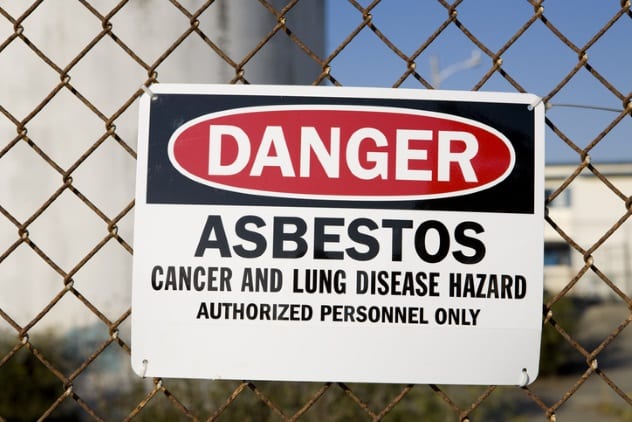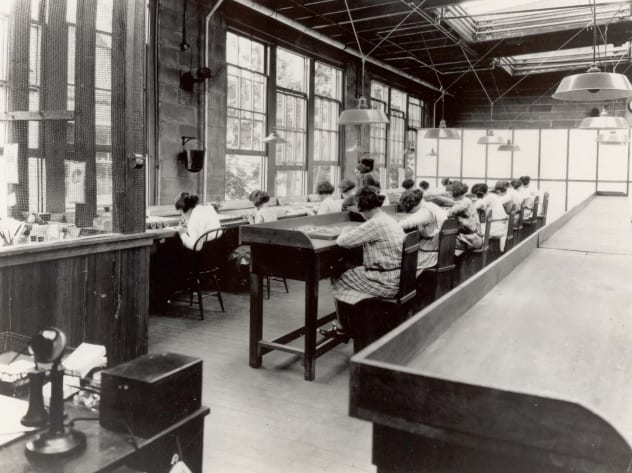 Animals
Animals  Animals
Animals  History
History 10 Most Influential Protests in Modern History
 Creepy
Creepy 10 More Representations of Death from Myth, Legend, and Folktale
 Technology
Technology 10 Scientific Breakthroughs of 2025 That’ll Change Everything
 Our World
Our World 10 Ways Icelandic Culture Makes Other Countries Look Boring
 Misconceptions
Misconceptions 10 Common Misconceptions About the Victorian Era
 Mysteries
Mysteries 10 Strange Unexplained Mysteries of 2025
 Miscellaneous
Miscellaneous 10 of History’s Most Bell-Ringing Finishing Moves
 History
History 10 Great Escapes That Ended Right Back in Captivity
 Weird Stuff
Weird Stuff 10 Fascinating Things You Might Not Know About Spiders
 Animals
Animals 10 Animals That Humiliated and Harmed Historical Leaders
 History
History 10 Most Influential Protests in Modern History
 Creepy
Creepy 10 More Representations of Death from Myth, Legend, and Folktale
Who's Behind Listverse?

Jamie Frater
Head Editor
Jamie founded Listverse due to an insatiable desire to share fascinating, obscure, and bizarre facts. He has been a guest speaker on numerous national radio and television stations and is a five time published author.
More About Us Technology
Technology 10 Scientific Breakthroughs of 2025 That’ll Change Everything
 Our World
Our World 10 Ways Icelandic Culture Makes Other Countries Look Boring
 Misconceptions
Misconceptions 10 Common Misconceptions About the Victorian Era
 Mysteries
Mysteries 10 Strange Unexplained Mysteries of 2025
 Miscellaneous
Miscellaneous 10 of History’s Most Bell-Ringing Finishing Moves
 History
History 10 Great Escapes That Ended Right Back in Captivity
 Weird Stuff
Weird Stuff 10 Fascinating Things You Might Not Know About Spiders
10 Times Corporations Poisoned People En Masse
Where there is great expansion, there is almost always great decay. This is the way of life, that when things grow, they do so by processes which neglect certain parts of their composition, necessarily leaving behind things which no longer suit the needs of the organism (or superorganism) so that it can adapt to its surroundings. This happens from the smallest organisms passing waste from themselves to make room for a new meal to the largest of societal structures, which often forget their roots, their purpose, and the individuals of which they’re composed.
We find ourselves in a world today where we look around at large, cumbersome, extremely powerful institutions that have often grown to an uncontrollable size, wondering what should we do if and when they turn on us. Sometimes, tragically, that’s precisely what happens, where the very institutions in which we place our trust turn against us in both overt and covert ways. When those who wield the power to make the decisions for such massive behemoths are wrong, they’re often gravely wrong, and people suffer as a consequence. Here are ten times corporations actually poisoned people and the stories surrounding each instance.
10 Michigan Chemical Corporation

The mistake was as simple as it was tragic, and the fallout still lives on to this day, more than 40 years later. The year was 1973, and a company called Michigan Chemical Corporation in, you guessed it, the state of Michigan, accidentally shipped their product to the wrong place—and the results were catastrophic. The company made two very distinct products, one called Nutrimaster and the other called Firemaster.
Nutrimaster was a trade name for magnesium oxide, and when it was put into the food and water sources of livestock, it would increase the milk production of the animals. Firemaster, on the other hand, was an extremely toxic flame retardant called polybrominated biphenyl (PBB). Both where very similar in appearance. One day, a truck was accidentally loaded with the wrong bags, grabbing Firemaster instead of Nutrimaster, and a highly toxic flame retardant was delivered to farms all over Michigan.[1]
Guess what happened next: The fire retardant got into the food supply and was absorbed into the animals as would be expected, with the most nightmarish of results. While most received relatively low doses, 70 to 90 percent of Michigan’s population are estimated to have become contaminated with the toxic substance through food intake, with some receiving rather high doses. While studies are still being conducted to this day to assess the extent of the damages, boys had genital and urinary tract problems, girls had menstrual problems and even a higher rate of miscarriages as adults, and many fetuses were exposed in utero. The reproductive effects seem quite severe at this point and may even prove to be worse as we discover more. This is how a single slipup can end up having far-reaching consequences for massive parts of the population.
9 Disneyland

When Richard Ramirez said, “See you in Disneyland,” this may or may not have been what he had in mind, but the next poisoning on the list didn’t come about from a contaminated food supply but rather a swimming pool. One day in August 2018, the guests of the New York Hotel at Disneyland Paris began to experience nausea and felt very sick while staff scrambled to figure out the cause. Tourists and staff alike were affected, and 22 people were ultimately poisoned by what turned out to be chlorine gas.
What had happened was an incorrect mixture of two chemicals for the pool at the hotel, when bleach and sulfuric acid were added to the water to treat it and keep it clean.[2] The mixture released chlorine, which is a common chemical used in liquid form to keep pools clean, but in its gas form, it can be highly toxic when breathed in high concentrations . . . and that’s exactly what happened. People were rushed to the emergency room, but ultimately, everyone survived, thankfully.
8 Camelford

In what became known as the Camelford water pollution incident, a similar mistake to that made by Michigan Chemical Company was made in North Cornwall, England, in 1988. Investigations ruled out foul play or any sort of malevolent attempts to harm people; the incident was just an accident with massive repercussions. Aluminum sulfate is sometimes added to water, making it easier to clean, and it was this chemical which was involved in the poisoning incident.
It all happened when a worker dumped 20 tons of the stuff into the water supply by accident, putting it in the wrong tank.[3] The Lowermoor Water Treatment Works, where the mistake was made, supplied water to over 7,000 homes, and people quickly began suffering some horrible effects, such as terrifying skin irritations and even their hair turning blue. While the total cost of these types of situations are hard to accurately measure, it’s thought that thousands suffered in total as a result, though thankfully most of the aluminum sulfate was processed by the bodies of the residents.
7 Fibreboard Paper Products Corporation

Believe it or not, use of asbestos goes back a long time, dating back to prehistory, up through the ancient times, and through the Industrial Revolution, when it rose to prominence. We should have known there was something not quite right about using the substance when we found Egyptian mummies wrapped in asbestos cloth to prevent degradation of the corpses.
The first asbestos-related victory in United States courts came in 1973 against a company called Fibreboard Paper Products Corporation, which had been using it as insulation without investigating the possible damages it could inflict—and those damages were vast. Most notably, it can lead to mesothelioma, a cancer which happens when asbestos fibers become lodged in the lung, causing cellular mutations.[4] Countless thousands of people were affected by it, even after the court case was won. In a terrifying turn of events, when the company was acquired by the Louisiana-Pacific Corporation in 1976, and later by Owens-Corning in 1997, these companies didn’t stop using asbestos, which was put into products still, even after the dangers had become known, until the 2000s.
6 DuPont

Even by DuPont’s own admission, the chemical known as PFOA would affect the lives of over three million people over the course of 60 years, as it was put into a whole slew of products. Its harmful effects wouldn’t become known until the 1970s, and it would astonishingly take until 2015 before the product was completely phased out due to a series of lawsuits. PFOA stands for perfluorooctanoic acid and has been used in the production of Teflon as well as various other commercial applications since the 1940s.
In 2001, DuPont had a leak at a plant in West Virginia which released the likely carcinogenic substance into the local water supply, and it would be successfully sued for the damages on the behalf of the residents who’d been exposed to the chemical.[5] The entire local water supply was contaminated with the substance, which also caused other illnesses. The really scary thing about PFOA is that it stays in the body ridiculously long and doesn’t get processed like most chemicals do, such as aluminum sulfate.
DuPont settled for a whopping $671 million in 2017 for all of the incalculable individuals who’d been affected. PFOA has been linked to testicular cancer, thyroid disease, hypertension and high cholesterol in some cases, and other various ailments. The company settled but still denied any wrongdoing in the incident.
5 Bhopal Disaster

The next on the list, the Bhopal disaster, has been called the worst industrial disaster in history. On the night of December 2, 1984, a pesticide gas managed to leak out of a factory in Bhopal, India. The highly toxic gas lingered and spread to the nearby neighborhoods. Unlike the other disasters on this list, thousands of people would die instantly as the gas crept in and slowly reached them. Tens of thousands of people fled in a sheer panic, terrified as others were dropping dead around them.
In total, around 600,000 people were exposed to the highly toxic gas, and the death toll was estimated between 3,800 and an astonishing 16,000 people. The company responsible was US-based Union Carbide, and some humanitarian groups say that toxic materials still remain buried underneath the ground at the site of the incident.[6]
4 US Radium Corporation

The United States Radium Corporation was responsible for painting the glowing parts on glow-in-the-dark watches during World War I and afterward.[7] This was done at a facility in Orange, New Jersey, from 1917 to 1926. The paint they were using, of course, was radium, and seeing as the men were off to war, the women were the ones who painted the watches for the war effort back at home. Suddenly and seemingly out of nowhere, many of the women started falling ill with varying symptoms . . . and then they started dying with a quick rapidity.
Their deaths were particularly quick because of the method the women were told to use while painting the dials on the watches, which included dipping the brush tips into the radium and then making a sharp, fine point with their mouths at the tip of each brush. They ingested straight radium and got quickly sick from radiation poisoning, and some were dying. Eventually, a lawsuit would come about, as the women had been told that radium was harmless.
3 Agent Orange

In 2018, Vietnam would start to make demands for reparations for damages they’d suffered roughly half a century earlier. A school janitor had sued the company Monsanto after contracting terminal cancer from using their product Roundup, setting a legal precedent.
Agent Orange is an herbicide that was used to eliminate foliage in Vietnam and deprive the Vietnamese of cover and food by killing all the plants they were growing and hiding in, but it is a highly cancerous substance that ripped through the Vietnamese civilian population as well. The effects of its use in the 1960s are still felt today. Birth defects and other diseases are known to have resulted from coming into contact with Agent Orange, and plenty of Vietnamese people suffered from birth defects after the war.
But this wasn’t the only case of the ingredients of Agent Orange poisoning people. US citizens were also poisoned by one of its components in the town of Nitro, West Virginia. Dioxin is one of the ingredients in the compound, and in 1949, an explosion in a plant in Nitro caused the workers there to be covered in it. Studies at the time somehow found dioxin nonpoisonous, though it definitely was poisonous, as the later use of it in Vietnam would prove.[8] Decades later, in 2014, Monsanto was ordered by the West Virginia Supreme Court to pay Nitro $93 million after all of the facts about the dangers of the substances being produced there came out.
2 Minamata Disease

Minamata disease is a relatively unheard-of ailment that was first learned of in Japan in 1956. A company called Chisso Corporation would be the culprit responsible and poisoned many people slowly over several decades.[9] Between 1938 and 1968, mercury-laced water runoff flowed out from the factory and into Minamata Bay in Kumamoto Prefecture.
It wouldn’t be until 1956 that a lone doctor would notice an incredible leap in the amount of patients he was treating for damage to their nervous systems. These patients were having spasms and seizures and were even dying on him. The condition he observed would later come to be called Minamata disease, and Chisso Corporation would be sued for the damages which resulted from the mercury-laced poisoning of a population over decades.
1 Depleted Uranium

Depleted uranium is a war crime, or so the Anti-Flag song goes. Ordnance tipped with depleted uranium has been linked to lymphoma, birth defects, kidney disease, bone cancer, neurological problems, other types of cancers, and a slew of other nasty health issues. But that didn’t stop the United States from employing it against Iraq during Desert Storm, and that wouldn’t be the last time—when Operation Iraqi Freedom came around, defense contractors galore dug out the depleted uranium munitions and decided to have a party, with catastrophic consequences.
Depleted uranium caused cancer in American troops thanks to the contractors who decided to employ it, along with other compounds used to tip munitions and make them more deadly, on the battlefield alongside the United States military.[10] This doesn’t even begin to touch on how many Iraqis may have been poisoned through explosions or shrapnel. The results have been catastrophic, and the US Department of Veterans Affairs, which cares for veterans who come back from war, still can’t keep up with the need for health care among the former troops.
Read about more shady corporate behavior on 10 Bizarre Schemes Corporations Have Tried To Get Away With and 10 Famous Companies With A Shocking Human Rights Problem.








